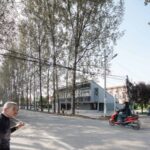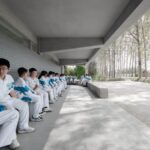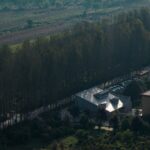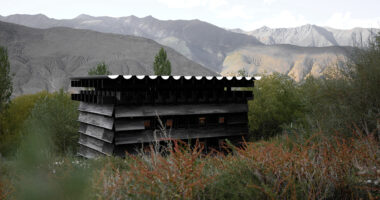Introduction
Situated within “The eighteen junior high school of Xi’an Hi-tech Zone,” the Qinfeng Library stands as a beacon of innovation and community engagement. Designed by Wall Architects of XAUAT in collaboration with the Samsung (China) Social Welfare Program, this project represents the second “Rural School Library” of the Hope Project in Shaanxi. With a focus on integration, mutualization, and ecological sustainability, the library embodies the values of progress and inclusivity.

Opening and Sharing
The Qinfeng Library is strategically positioned in the southeast corner of the school, adjacent to major rural roads. This deliberate placement ensures that the building serves as a bridge between the school and the surrounding community. The design emphasizes open, shared spaces, including a semi-outdoor area under the eaves and a spacious first floor accessible to both students and villagers. These versatile spaces facilitate cultural exchange, educational activities, and community gatherings, enriching the cultural fabric of the countryside.

Ecological Sustainability
In collaboration with the Zero Energy & Zero Carbon Building Research Team of Xi’an University of Architecture and Technology, the design of the Qinfeng Library prioritizes ecological sustainability. The building’s orientation, form, and openings are optimized to maximize solar radiation in winter while promoting natural ventilation and cooling in summer. A single-slope roof design minimizes sunlight exposure to the north, while strategically placed skylights ensure year-round natural daylighting and ventilation. Powered by photovoltaic (PV) technology, the library operates as a fully DC-powered building, reducing its carbon footprint and energy costs.


Technological Innovation
The Qinfeng Library is equipped with state-of-the-art monitoring equipment, allowing for real-time data collection and analysis. This data is transmitted to the cloud, providing valuable insights for the advancement of low-carbon building technologies. Despite facing challenges during construction, including rural conditions and cost constraints, the library serves as a pioneering model for rural development and public welfare in Shaanxi. It aligns with national and provincial initiatives aimed at promoting zero-carbon buildings and building-integrated photovoltaics (BIPV), contributing to China’s broader sustainability goals.

Conclusion
The Qinfeng Library exemplifies the transformative power of architecture in fostering community resilience and ecological stewardship. By prioritizing inclusivity, sustainability, and technological innovation, this project represents a forward-thinking approach to rural development. As a catalyst for positive change, the library serves as a testament to the potential of collaborative efforts in addressing pressing societal and environmental challenges.























